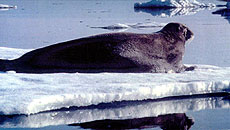Bearded Seal
Bearded Seal Sounds (Erignathus barbatus)
Description

Bearded seal on ice in the Arctic. Photo courtesy of OSAP/IOS CANADA.
Bearded seals are cold water seals that live in the circumpolar regions of the northern hemisphere. These seals are named for their long, numerous whiskers that are prominently displayed over a deeply set lower jaw. Bearded seals can also be identified by their square shaped front flippers. Due to this unusual characteristic, which is caused by their third digit being slightly longer than the others, Norwegian sealers used the name “square flipper” to refer to these animals. This species name is still known today in some Canadian provinces. Bearded seals are the largest phocids living in the northern regions. Adults are 2-2.5 m (6.5-8.2 ft) long and weigh 200-250 kg (440-550 lb) on average. Females are often larger than males. Bearded seals are gray-brown in color. Newborn pups have white patches on their faces. These seals tend to be solitary in nature, but they can also been seen hauled out on pack ice in small groups. Making use of their long vibrissae, bearded seals are benthic feeders, hunting in shallow continental shelf areas throughout the Arctic. Their diet consists mainly of crabs, shrimps and clams but they may also take fish, particularly arctic cod. Diets vary seasonally and geographically. Polar bears, walrus, and killer whales are the natural predators of bearded seals.Male bearded seals are among the most vocal of marine animals. They produce distinctive, stereotyped calls ranging from 0.02 – 11 kHz in frequency. These complex vocalizations consist of long, spiraling trills; shorter sweep calls; flat, tonal grunts; and short, low frequency moans, which show clear geographical variation. As they sing, bearded seals dive slowly in a loose spiral, releasing bubbles and finally surfacing in the center of the circle they’ve made. Bearded seals breed in the water, and the long trilling songs of the males are thought to advertise their breeding condition to nearby females. It is likely that trill duration indicates male “quality,” with longer trills implying increased fitness and reproductive success. The vocalizations are only heard during the breeding season which lasts for about 90 days, from about late March through mid July.

Bearded seal pup, Photo courtesy of NOAA Fisheries
Additional Resources
- NOAA NMFS Species Directory – Bearded Seal